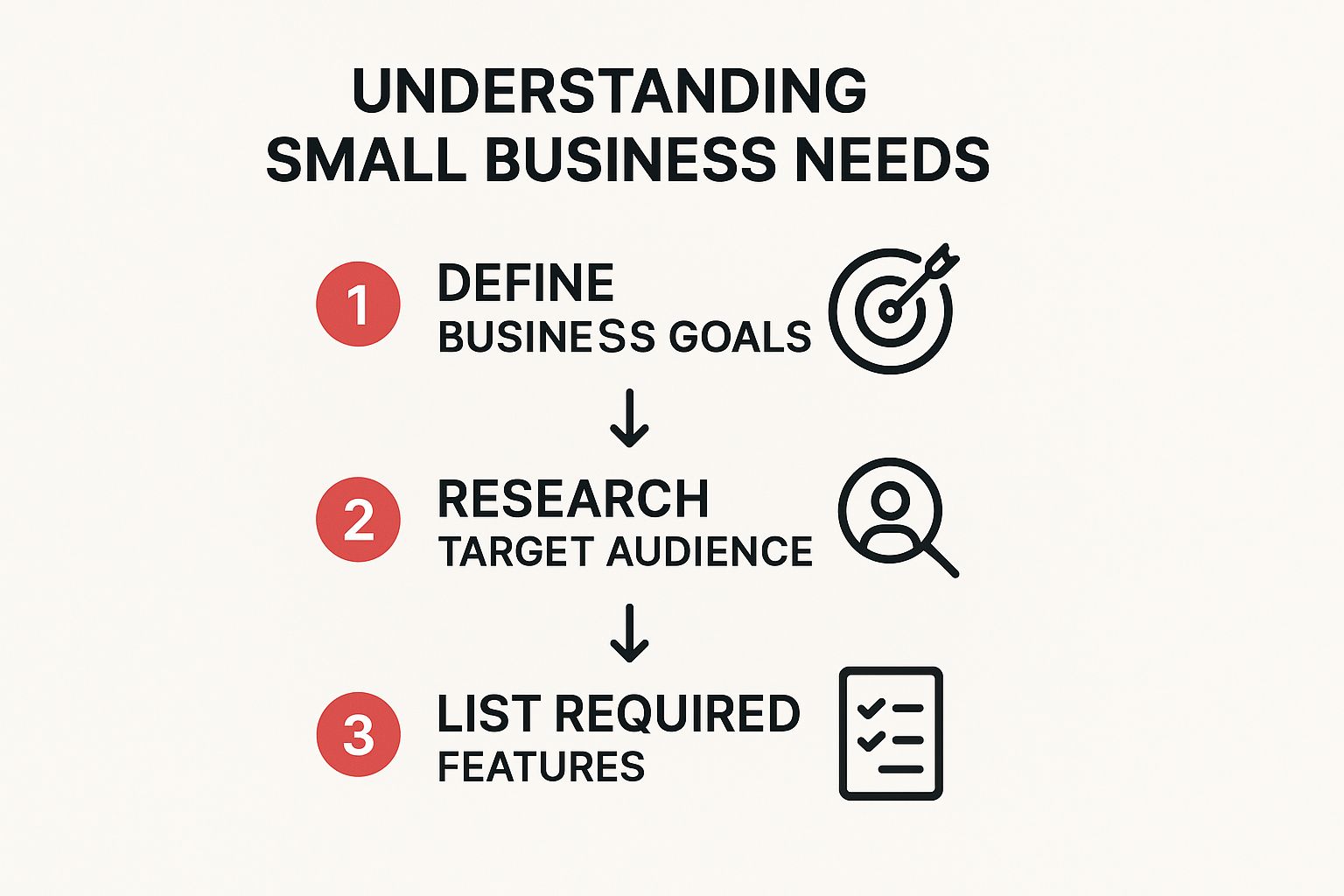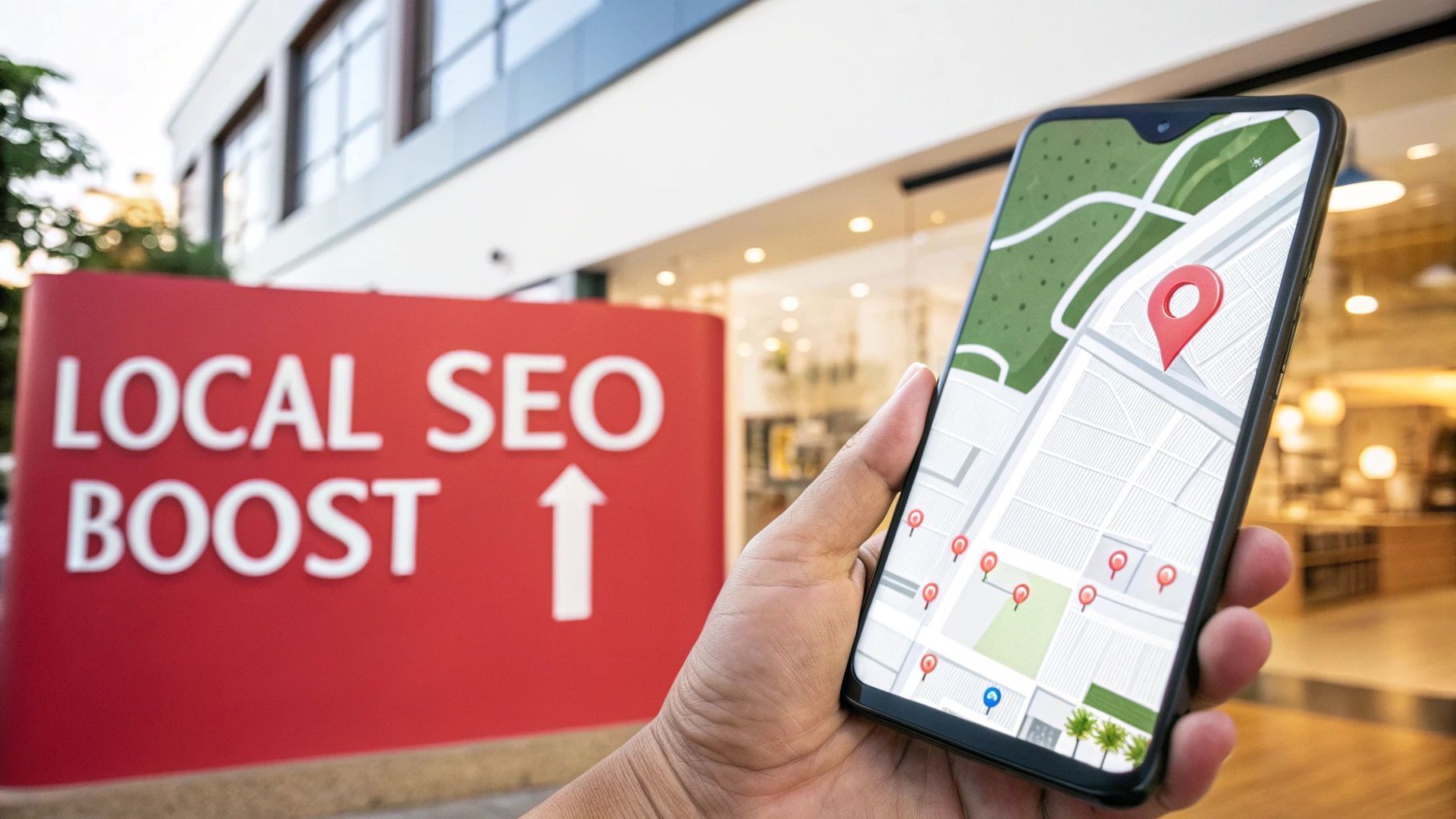Website Design for Small Business UK A Complete Guide
Having a great website design for your small business in the UK is not a "nice-to-have" any more. It’s the very core of your digital identity. Think of it as your hardest-working employee, one that never sleeps.
A professional, slick website is your digital front door, open 24/7, building instant trust and credibility in what has become a very crowded marketplace.
Why Your Website Is Your Most Important Employee
Picture your business as a shop on the high street. A potential customer is far more likely to pop into a store with a clean, well-organised window display than one that looks messy and unloved, right? Your website works in exactly the same way.
It is often the very first time a potential customer ever interacts with your brand. That first impression is made in a split second, and it is powerful enough to make them either stick around or click away forever. A clunky, outdated, or confusing site just screams a lack of care, and people will naturally assume that reflects on your products or services.
On the flip side, a brilliant website acts as your best salesperson, marketer, and customer service rep, all rolled into one. It works around the clock, showing off what you do, answering questions, and gently guiding visitors to take that next step—whether that is buying something, asking for a quote, or booking a call.
Building Trust in a Crowded Market
In the UK, small and medium-sized businesses (SMEs) are the lifeblood of the economy, making up a staggering 99.9% of all businesses . With that much competition, you have to establish credibility, and fast. This is where your website becomes non-negotiable. If you want to dive deeper into the stats, Top10-WebsiteHosting.co.uk has a great breakdown on the role of SMEs in the UK.
A strong online presence lets you stand toe-to-toe with the big players, levelling the playing field. A few key things build this foundation of trust:
- A Professional Look: A modern, clean design shows you’re a serious, legitimate business.
- Clear Information: Easy-to-find contact details, service descriptions, and pricing build confidence.
- Consistent Branding: Using your logo, colours, and tone of voice consistently makes your brand memorable.
Your website isn’t just an online brochure; it is a dynamic tool for growth. See it as a critical investment that brings in leads, builds relationships, and drives revenue—not just another tick box expense.
Ultimately, a well-thought-out website gives your brand a permanent home online. Unlike social media platforms where the rules can change overnight, you have total control over your site's content, message, and the experience people have with it. That control is vital for building a brand that lasts, connects with the right people, and helps you hit your business goals for years to come.
Creating Your Website Blueprint Before You Build
You would not build a house without a detailed architect's blueprint, would you? You’d end up with a wonky, chaotic mess that does not do what you need it to. Building a website is exactly the same. A solid plan is the foundation for everything that follows.
It’s so tempting to jump straight into the fun stuff, like picking out colours and fonts. But that’s a classic mistake. The crucial planning stage, what we call the discovery phase , is where your vague ideas get hammered into a concrete strategy. It’s what ensures the finished website is perfectly aligned with what your business actually needs to achieve.
This phase is all about asking the right questions before you invest a single penny or minute into the build. By figuring out what your website needs to do and who it needs to serve , you create a clear roadmap that guides every single decision from here on out.
Define Your Website's Core Purpose
First things first: what is this website for? Seriously. What is its number one job?
Is it there to sell products directly through an online shop? Or is its main purpose to get potential customers to pick up the phone or fill out a contact form?
Your primary goal dictates the entire design and structure. A website for a local plumber in Manchester has completely different priorities to one for a UK-wide online craft shop. It’s a different beast entirely.
Think about which of these common goals fits your business best:
- Generate Leads: The site’s main job is to collect contact details from potential customers.
- Sell Products Online: This is a classic e-commerce setup, needing product pages, a shopping cart, and a secure checkout process.
- Establish Credibility: A portfolio site to show off your work and build trust with clients who are on the fence.
- Provide Information: The website acts as a central hub of information, maybe for a local community group or an annual event.
Once your main goal is clear, you can think about secondary ones. For example, an e-commerce site’s primary goal is sales, but a secondary goal might be to build an email list with a newsletter sign up.
Defining your business objectives is the single most important step in this whole process. Every page, every feature, every word on your site should support these goals. Without that clarity, you risk building an expensive digital business card that does absolutely nothing.
Understand Your Ideal UK Customer
Right, you know what you want. Now, who are you talking to?
It’s time to create a customer persona . This sounds a bit like marketing fluff, but it is an incredibly practical exercise. A persona is just a semi-fictional snapshot of your ideal customer. Give them a name, an age, a location in the UK, a job. What keeps them up at night? What problems are they trying to solve when they stumble across your website?
Remember, a whopping 73% of consumers say a good customer experience is a massive factor in their buying decisions. That experience starts the moment they land on your site, and it’s only good if you truly understand what they need.
This infographic breaks down how these initial steps flow into one another.

As you can see, defining your goals, researching your audience, and then listing out the features are all sequential. Each step builds on the last, giving you a rock-solid strategic foundation.
Map Out Your Website's Structure and Features
With your goals set and your ideal customer in mind, you can finally start mapping out the nuts and bolts of the website itself. This means creating a sitemap and listing out all the features you will need.
A sitemap is not complicated; it is just a simple list of all the pages your website will have, organised in a logical way (e.g., Home, About Us, Services, Blog, Contact).
Next, list the specific features required to meet your goals. Let's say you are a personal trainer. You’d probably need:
- A booking system for clients to book their sessions.
- A gallery to show off impressive client transformations.
- A blog to share fitness tips and pull in visitors from Google.
- Testimonials to build that all important trust and social proof.
Going through this blueprinting process takes the guesswork out of the equation. It saves you time, money, and a lot of headaches, ensuring your website design for a small business in the UK becomes a powerful tool for growth, not just another pretty page on the internet.
To help you get started, we have put together a simple checklist to guide your thinking.
Core Website Planning Checklist for UK SMEs
| Planning Stage | Key Questions to Answer | Example for a UK Bakery |
|---|---|---|
| 1. Business Goals | What is the #1 thing this site must achieve? What are secondary goals? | Primary: Get customers to place online orders for local delivery. Secondary: Build our email list for special offers. |
| 2. Target Audience | Who is our ideal customer? What are their needs and pain points? | "Busy Mum Bev," 35-45, lives locally, needs quick and easy treats for family events, values quality ingredients. |
| 3. Core Message | What is the one key message we want visitors to remember? | "Handmade, delicious cakes and breads, delivered fresh to your door in Bristol." |
| 4. Key Features | What tools does the site need to achieve its goals? | Online ordering system, menu pages with high-quality photos, an "About Us" page telling our story, a contact form. |
| 5. Competitor Analysis | What are local competitors doing well online? Where are the gaps? | The Posh Loaf has great photos but no online ordering. Cake Corner has online ordering but a confusing website. |
| 6. Content Needs | What pages do we need? What information/images are required for each? | Home, About, Menu (Cakes, Breads, Pastries), Order Online, Contact. We will need professional photos of all our products. |
This checklist is not exhaustive, but it covers the absolute essentials. Work through it honestly, and you will have a blueprint that any designer or developer can use to build you a website that actually delivers results.
Choosing Your Build Method: DIY vs. Hiring a Pro

So, you’ve got your blueprint. Now for the million-dollar question: who is actually going to build this thing? Think of it like needing a new garden shed. You could grab a flat pack kit and spend a weekend figuring it out yourself, or you could hire a carpenter to build you something solid and bespoke. That is the exact choice you're facing with your website.
This is a biggie. It really boils down to two paths. You can either roll up your sleeves with a Do-It-Yourself (DIY) website builder or invest in a professional web designer. There’s no single right answer here—it all depends on your budget, your timeline, how tech savvy you feel, and what you want your website to achieve in the long run.
Let's get real about the pros and cons of each route.
The DIY Website Builder Route
Platforms like Wix, Squarespace, and Shopify have opened the doors for anyone to create a decent looking website without knowing a scrap of code. They’re mostly drag and drop, meaning you pick a template you like and then slot in your own text, images, and colours.
It’s an empowering path for a lot of small business owners, and there are various website builder tools out there that make the process pretty straightforward.
Key Advantages of DIY:
- Lower Upfront Cost: This is the big one. Instead of a hefty project fee, you’re looking at a manageable monthly or annual subscription.
- Full Control: Want to change a sentence at 10 pm? Go for it. You have direct access to make tweaks whenever you need to, without waiting on someone else.
- Speed to Launch: If your content is ready to go, you could technically get a basic site up and running over a weekend.
But let's be honest, the DIY approach has its pitfalls. That initial cost saving often gets paid for with your time. What looks simple can quickly spiral into a frustrating time sink, pulling you away from actually running your business. And while templates are a great start, they can feel restrictive, making it tough to stand out or add unique features as your business grows.
Hiring a Professional Web Designer
The alternative is to bring in the cavalry: a freelance designer or a web design agency. This is your expert carpenter. You are not just paying for a website; you are paying for their experience, their skill, and their ability to build something perfectly tailored to you.
This is about so much more than just making things look pretty. A pro gets user experience, search engine optimisation (SEO), and how to turn visitors into customers. They build with your business goals front and centre, transforming your site from an online brochure into a lead generating machine.
A professional website designer doesn’t just build what you ask for; they build what your business needs. Their expertise lies in translating your goals into a digital experience that connects with your audience and drives results.
Key Advantages of a Professional:
- Custom Design: You get a website that is uniquely yours, reflecting your brand and setting you apart from competitors using the same old templates.
- Expertise and SEO: A professionally built site is optimised for Google from the ground up, giving you a much better shot at being found by new customers.
- Saves You Time: This is huge. Outsourcing the build frees you up to do what you do best—run your business.
The main drawback, of course, is the higher upfront investment. A custom website is a serious business asset, and the price reflects that. But for many, the return on that investment, through new leads and enhanced brand credibility, makes it a no brainer. For a deeper dive into this decision, check out our guide on choosing between a DIY or Pro website.
Making the Right Choice for Your Business
So, how do you decide? Sometimes seeing it laid out helps.
| Factor | DIY Website Builder | Professional Web Designer |
|---|---|---|
| Budget | Low monthly fees, minimal upfront cost. | Higher one off investment ( £2,000 - £10,000+ ). |
| Time | Requires a significant time investment from you. | Frees up your time to focus on your business. |
| Customisation | Limited by template functionality. | Fully bespoke design tailored to your brand. |
| Scalability | Can be difficult to add complex features later. | Built with future growth and scalability in mind. |
Ultimately, it comes down to this: if your budget is extremely tight, you have plenty of time on your hands, and your needs are simple, a DIY builder is a fantastic place to start. But if you see your website as a core driver of growth and want a unique, high performance presence online, hiring a professional is one of the smartest investments you can make.
Key Design Principles That Win UK Customers

Great website design is about more than just looking good. It’s about creating an experience that feels effortless and welcoming for every visitor. Think of it like digital hospitality—you want people to land on your site, find what they need without any fuss, and leave thinking highly of your business.
For a UK small business, mastering these principles is what turns a casual browser into a loyal customer. It’s the invisible stuff—the simple layout, the familiar branding—that builds trust and quietly guides people to take the next step.
Embrace a Clean, Uncluttered Layout
Have you ever walked into a shop so cluttered you did not know where to look first, so you just walked straight back out? A messy, chaotic website has exactly the same effect. People crave order, and a clean, spacious layout helps them focus on what really matters: your message.
This is often called minimalism . It is not about having almost nothing on the page; it is about making sure everything that is on the page serves a purpose. Using plenty of "white space"—the empty areas around text and images—gives your content room to breathe and makes it far easier to read.
This simple approach makes your calls to action, like "Buy Now" or "Get a Quote," really pop. A clean layout is the bedrock of a good user experience and a non-negotiable part of any solid website design for a small business in the UK .
Prioritise a Mobile First Design
Here’s a number for you: a staggering 98% of UK adults aged 16 to 44 use a smartphone. That means the vast majority of your potential customers will first see your website on a small screen, probably while they’re on the move. That is why a mobile first design is not just a good idea—it is essential.
This approach means designing for the smallest screen first and then adapting the design for larger desktops, not the other way around. It forces you to prioritise the absolute most important information, ensuring a slick, focused experience for everyone, regardless of their device.
A site that works perfectly on a phone keeps people scrolling. One that makes them pinch, zoom, and struggle will send them straight to your competition.
A mobile first approach isn't just about shrinking your desktop site. It’s about completely rethinking the user journey for a mobile context, ensuring it is fast, simple, and incredibly easy to navigate with a thumb.
Build Trust with Consistent Branding
Your brand is your business’s personality. Consistency is how you make that personality recognisable and, crucially, trustworthy. Every time someone interacts with your business—on your website, social media, or even a leaflet—the look and feel should be the same.
This means getting a few core elements right and sticking to them:
- Logo: Make sure it is clear, prominent, and used consistently on every single page.
- Colour Palette: Stick to your defined brand colours to create a cohesive, professional feel.
- Typography: Use the same one or two font families throughout your site. It keeps things tidy.
- Tone of Voice: Whether you’re professional, friendly, or a bit quirky, make sure your writing style reflects your brand's personality.
This consistency signals professionalism and reliability. When customers recognise your branding, they feel more comfortable, and that feeling of comfort is a huge step towards making a sale. For more practical advice, take a look at these 10 essential website design best practices for 2025.
Make Your Website Accessible to Everyone
Finally, a truly great design is an inclusive one. Web accessibility is simply about making sure your website can be used by everyone, including people with disabilities. This is not just the right thing to do; it’s a smart business move that opens you up to a wider audience and can even give your SEO a boost.
This means thinking about things like legible fonts, providing text descriptions for images (alt text), and ensuring your colours have enough contrast to be easily read. It is about designing a site that works brilliantly for every visitor, not just most of them.
By putting these principles at the heart of your website plan, you’ll end up with a site that doesn’t just look the part, but one that genuinely works for your business and your customers.
Getting Found on Google With SEO and Performance
Having a brilliant website is a great first step, but what’s the point if your customers can’t find it? If you’re buried on page ten of Google, you might as well be invisible. This is where Search Engine Optimisation (SEO) and website performance come into their own.
Think of SEO as the digital signposts you leave across the internet, all pointing people back to your website. Performance, on the other hand, is the experience they have once they arrive—is it fast, smooth, and professional, or clunky and slow? For any UK small business, getting these two things right is non-negotiable.
Understanding How Your UK Audience Searches
The first rule of SEO? Get inside your customer’s head. What are they actually typing into Google when they’re looking for what you sell? These search terms are your keywords .
Don’t just guess. Use free tools like Google’s Keyword Planner to see what real people in your area are searching for. If you’re a plumber in Bristol, ranking for “plumber” is a long shot. Instead, you should be targeting phrases like “emergency plumber Bristol” or “boiler repair Southville”. These longer, specific phrases attract customers who are much closer to making a decision.
Once you’ve got a solid list of keywords, you need to weave them naturally into your website. Make sure they appear in:
- Page Titles: This is the main headline that shows up in Google’s search results.
- Meta Descriptions: The short bit of text under the title. A good one makes people want to click.
- Headings and Body Text: Including keywords here helps Google figure out what each page is about.
The Need for Speed: Website Performance
Imagine a potential customer walking up to your shop, but the door takes ages to open. They’d get fed up and leave, right? Your website is exactly the same. A slow loading site is one of the fastest ways to lose a sale and drop down the Google rankings.
It’s not just a hunch. Google themselves say that if a page takes three seconds to load instead of one, the chance of a visitor leaving jumps by 32% . Speed is not just a techy detail; it’s fundamental to the customer experience.
One of the biggest culprits for a sluggish website is massive image files. Getting your head around image optimization for web performance is a game changer.
Your website’s performance directly impacts your bottom line. A faster website leads to better user engagement, higher conversion rates, and improved search engine rankings, creating a powerful cycle of growth for your small business.
Choosing the Right UK Web Hosting
It also matters where your website ‘lives’ online. Your web host is the company that stores all your website’s files and serves them up to visitors. For a UK business, choosing a UK-based host can give you a small but significant performance edge.
When the data does not have to travel as far across the globe, your site can load that little bit quicker for your local customers. It might only be a fraction of a second, but it all adds up to a better experience.
This local hosting advantage, combined with smart SEO, gives your website design for a small business in the UK the best possible shot at being found, and loved, by the right people.
Your Go Live Checklist and Ongoing Maintenance Plan

Getting your new website live is a massive milestone, but it’s the starting pistol, not the finishing line. Think of your website as a living, breathing asset for your business; it needs regular care and attention to keep performing at its peak. Before you flick that switch, a final, thorough check is non-negotiable for a smooth launch.
This pre-launch checklist is your last line of defence. It’s all about catching the small glitches that could frustrate your first visitors before they even have a chance to see them. A brilliant first impression is everything. From there, a proactive approach to maintenance ensures your site remains a powerful tool for growth long after launch day.
Your Essential Pre-Launch Checks
Before you go live, you need to put yourself in your customer's shoes and methodically test every single part of the site. It sounds tedious, but a tiny broken link or a contact form that does not submit can be the difference between winning a new customer and losing them forever.
Here are the absolute must do checks:
- Test Every Link: Click on everything. The navigation menu, the social media icons, the links in your footer—make sure every single one goes exactly where it is supposed to.
- Check All Forms: Fill out and submit every form on your website. That means your contact form, quote requests, and newsletter sign ups. Do they work? And, just as importantly, do you actually receive the notification?
- Review on Multiple Devices: Your site has to work everywhere. Check how it looks and functions on different smartphones, tablets, and desktop browsers. What looks perfect on an iPhone might be a complete mess on a Samsung or a different web browser.
- Proofread Everything: Read every single word one last time. Better yet, get someone else to. Typos and sloppy grammar make a business look unprofessional and can erode trust instantly.
Think of your website like a brand new car. You would not drive it off the forecourt without checking the mirrors, testing the brakes, and making sure the indicators work. Your pre-launch check is the digital equivalent—a final inspection to guarantee a safe and successful journey.
Keeping Your Website Healthy and Secure
Once your site is live, the work shifts from building to maintaining. A neglected website can quickly become slow, insecure, and outdated, which seriously damages both your user experience and your Google rankings. An ongoing maintenance plan is not a "nice-to-have"; it’s essential for protecting your investment.
Regular upkeep comes down to a few key jobs. Software updates are crucial for patching security holes and keeping everything running smoothly. Regular security scans help you spot and block malicious threats before they cause damage. And consistent backups are your safety net, allowing you to restore your site in minutes if the worst happens.
This ongoing work is vital, but it can be a real time drain for a busy business owner. This is where exploring professional website maintenance services in the UK can be a smart move, freeing you up to focus on what you do best—running your business.
Finally, start getting familiar with your website's analytics. Tools like Google Analytics give you incredible insight into how people find and use your site. Understanding this data is the key to making informed decisions and continuously improving your website’s performance over time.
Your Questions Answered: Small Business Website FAQs
Getting a website off the ground can feel like navigating a maze, especially when you're juggling the day-to-day of running a business. To cut through the noise, we have tackled the most common questions UK small business owners ask us.
Here are the straight answers to help you move forward with confidence.
How Much Should I Actually Budget for a Website?
This is always the first question, and the honest answer is: it really depends.
You could go the DIY route with a builder like Squarespace or Wix for a few hundred pounds a year. It is a solid choice if the budget is tight and you just need to get something online quickly.
But for a professional, custom built website for a small business in the UK , you’re looking at an investment of anywhere from £2,000 to £10,000+ . That price gets you a proper partner—a freelancer or agency that digs into your strategy, design, development, and initial SEO. It is not just a website; it is a business asset built to grow with you.
How Long Does It Take to Build a Website?
The timeline is all about the scope. If you are using a simple template and have all your text and images ready to go, you could realistically get a basic site live over a weekend.
A professional build is a different beast entirely. A typical project takes between 4 to 12 weeks . Why so long? Because it’s a thorough process. That timeframe allows for proper discovery, design concepts, back and forth revisions, and rigorous testing to make sure the final product works perfectly and hits your business goals.
Do I Really Need a Blog on My Business Website?
It’s not a must have for every single business out there, but a blog is hands down one of the most powerful ways to get found on Google. Think of it this way: every single post is a new hook in the water, a new chance to rank for what your ideal customers are searching for.
A blog helps you:
- Boost Your SEO: Fresh, relevant content tells search engines your site is alive and kicking, which they love.
- Establish Your Expertise: Sharing what you know builds trust like nothing else. It shows you’re the real deal.
- Answer Customer Questions: You can tackle common problems and guide people towards the solution you offer.
Do not think of a blog as a diary. It is a strategic library of resources built to answer your customers' most urgent questions. It’s a marketing asset that works for you 24/7, pulling in traffic and leads long after you’ve hit publish.
Ultimately, a blog that’s looked after properly can be an absolute game changer for your visibility and credibility online.
Ready to build a website that does the heavy lifting for your business? The team at Superhub specialises in creating high performance websites that deliver real results. Get in touch with us today and let's talk about your project.





